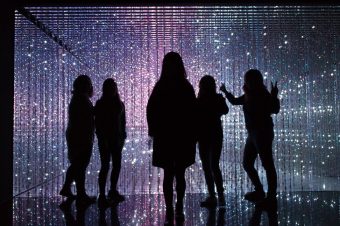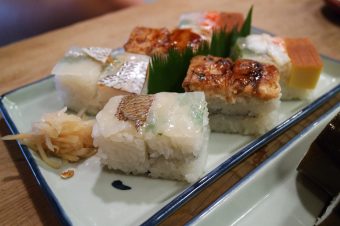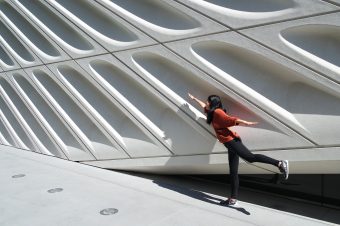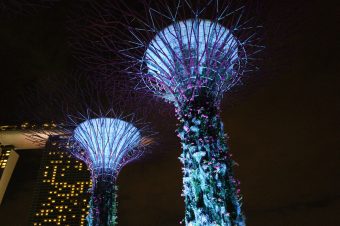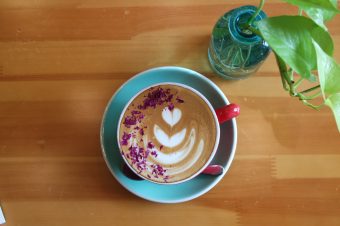Osaka was so nice, we are seriously considering moving there. The flat we Airbnb’d in was #goals. First and foremost, the food there was simply amazing. It’s no wonder that Osaka is also known as the “nation’s kitchen” (天下の台所 tenka no daidokoro). Although Osaka gave off less of a historical ambiance in comparison to Kyoto, it is a bustling city that is full of festivities and many things to do and see.
We spent 3 nights in Osaka as our home base and made day trips to Kyoto and Hiroshima.
Dotonbori (or Dotombori) 道頓堀
We made our very first stop at Dotonbori because we were staying in this area. Dotonbori runs parallel to the Dotonbori canal, stretching from Dotonboribashi Bridge to Nipponbashi Bridge in the Namba district. It used to be a theatre district but is now one of Osaka’s most popular nightlife and entertainment area. It is also a great place to satisfy any of your food cravings! This area is always bustling as some restaurants here are opened 24 hours.
Fun fact: Osaka is also known as the city of “kuidaore,” (食い倒れ) meaning “to ruin oneself by eating and drinking to excess.” It came from a larger proverb: “Dress (in kimonos) till you drop in Kyoto, eat till you drop in Osaka” (京の着倒れ、大阪の食い倒れ).
Directions: Take the Sennichimae Subway Line to get to Namba Station.
(Note: Namba Station is not a single station, but rather a collection of multiple station buildings and platforms, including Nankai Namba Station, JR Namba Station, and Kintetsu’s Osaka Namba Station; the Midosuji, Yotsubashi and Sennichimae Subway Lines also stop at their respective Namba Stations)
Points of interest:
- Sennichimae Doguyasuji Shopping Street: This street can be roughly translated into “Cooking Tools Street”. It’s a 150 meters long shopping arcade dedicated to providing cooking tools and equipment. Any cooking ware or restaurant-related things you can think of, from knives and takoyaki grills to neon signs and plastic food models, can be found here.
- Glico Running Man Billboard: Seen as an icon of Osaka, this billboard is a prominent feature of Dotonbori. The Glico billboard shows the image of a runner crossing a finishing line.
- Ebisubashi: This bridge, located right under the Glico Running Man Billboard, connects Shinsaibashi-suji and Ebisubashi-suji shopping districts. It’s a popular meet-up point for people since the Glico Man is so recognizable.
- Kani Doraku Crab Sign: This huge crab sign (built in 1960) in front of the crab restaurant Kani Doraku has mechanical arms and eyes that can move! One of the icons of Dotonbori.
- Blowfish lantern of Zubora-ya: This blowfish lantern marks the front entrance of Zuboraya, a restaurant that specializes in dishes using – you guessed it! – blowfish. However, Zuboraya says that it not only serves blowfish, but also a variety of other fish as well.
- Kuidaore Taro: While walking down the street in Dotonbori, we saw this icon everywhere! After a little digging, we discovered that he is an integral part of the identity of Osaka. As mentioned before, Osaka is also known as the city of “kuidaore” and Kuidaore Taro is a symbolic representation of that name. You can read more about Kuidaore Taro here and here.
Food and Restaurants
(head over to our Osaka food guide for more!) some highlights:
- Okonomiyaki @Mizuno (Michelin starred)
- Rikuro Ojisan no Mise Cheesecake (SO FLUFFY!!!!)
- Yakiniku (Japanese BBQ)
- Tokoyaki
Osaka Castle 大阪城天守閣
We went to Osaka Castle early in the morning as it opens at 9am and we wanted to save enough time to visit the owl cafe in the afternoon (we heard the cafe usually has a wait). When we got there we were surprised to see many people walking along the streets in rows, all dressed in festival and performance clothing. Turned out that there was some sort of festival/competition going on that day. Groups from different cities of Japan, such as Tokyo, Kyoto, and Nagoya, came to the Osaka Castle to perform and compete. Most of the cities were represented by college student groups (we saw Ryukoku University Kaburyu for example), but there were some groups that had older people and/or children as well. The performances were so fun and upbeat and, not to mention, the costumes were all so colorful and beautiful – I loved it! To think it would be so nice for us to have something like this more often in the U.S. too, where people can come together in public spaces to gather and celebrate traditions, and not just for public holidays. It was almost like a flash mob, only 10 times better. I really wished we could have stayed to watch each and every performance but we were on a time crunch!
Entrance fee to Osaka Castle is 600 yen. After getting your ticket, you can choose to take the elevator up to the 5th floor and walk up to the 8th floor (which is the highest floor) before making your way back down OR you can choose to skip the line for the elevator and just walk up the stairs to all 8 floors. On such a hot day that’s nearing 85°F, it’s probably pretty obvious which method we chose…
A little history…
The construction of the Osaka Castle first started in 1583 and was completed in 1597. Its construction was commenced by Toyotomi Hideyoshi, who ruled Japan during the Sengoku Period. After Hideyoshi died, the Osaka Castle fell to the Tokugawa clan in 1615. Since then, the castle has burned down multiple times due to various factors (fires, conflicts, wars, etc.) and the original Osaka Castle is no longer standing. As we saw inside the castle museum, the Osaka Castle today has been restored to its Edo Period splendor, which looks very different from the one that was first built. The latest restoration of the castle was finished in 1997. The interior of the castle has been completely renovated into a museum that include elevators and air conditioning. The castle museum depicts the history of the castle, focusing most on the power struggle between the Toyotomi and Tokugawa clans.
On the first floor, there was a room showcasing trailers from the new movie that is based on this history. Seems like a big production with a lot of positive anticipation. The movie is slated to be released on 9/22/2016.
Directions: Take the Tanimachi Subway Line or the Chuo Subway Line to get to Tanimachi 4-chrome (Tanimachiyonchome) Station, which is the closest station to the castle.
Other points of interest around Osaka Castle:
- Nishinomaru Garden: Best time to come here is during the Fall or Spring time.
> This garden park is a popular place for people to walk around and admire the beautiful fall colored leaves during the autumn season. This is my favorite season and I really wanted to bask in the glorious beauty that is autumn. Unfortunately, I was in for little disappointment because we came to visit a bit too early this year. We were there 9/13-9/18/2016 but the first of Japan’s fall colors in the Kansai region apparently didn’t start until 9/22…so close!
> Another good time to visit this garden is in April. Famous for its 600 cherry trees that bloom gloriously during the spring time, the park is one of Osaka’s most popular hanami (flower viewing) spots during the cherry blossom season. Night cherry blossom viewing events are also held during the blooming periods. Entrance fees: ¥200 (evening time in the cherry blossom season: ¥350) - Minami-Temma Park 南天満公園: Right across the river from the Osaka Castle, this public park extends along the Kyū-Yodo River (also called Ogawa). It is a great place to ride your bike leisurely or host your own barbecues (the park has barbecue areas). It is also another great cherry blossom viewing spot. At night, all the lights along the river turns on and it’s beautiful. You also have the option to take a riverboat for a mini cruise along the river.
- Osaka-jō Hall 大阪城ホール: Viewable form the Osaka Castle, this multi-purpose arena is where a lot of major concerts are held, so if you’re into J-pop or K-pop, the artists often perform here 🙂
- Yatai (屋台) or food stalls, are a huge part of festivals in Japan. If you love to eat, this is the perfect chance to get your fill! Not sure if these particular food stalls were here because we happened to be having a festival that day, but some of them looked pretty stationary just outside of the castle. You can wander around and sample a large variety of Japanese foods at a decent price. My sister and I treated ourselves to some cherry-blossom flavored shaved ice (¥500) after coming out of the castle because it was such a hot day. Cherry-blossom flavored must sound a little weird at first but it was absolutely amazing. It was subtly sweet and the pink color was so pretty (yes yes I admit that I’m easily sold on appearances). We also had some really good beef and squid skewers, which is another specialty of Osaka, for ¥100 per piece.
Owl Cafe
Finally! I have been looking forward to this ever since I found out about its existence. Cat cafes, dog cafes, and bunny cafes are already very popular, but in recent years this new one has also started making its name around town – OWL CAFE!! Not only is this making my Harry Potter dreams come true, I will also finally be able to pet one of those cute owls that you see on YouTube videos.
After leaving Osaka Castle, we headed over to the Owl Family Cafe located inside the Tenjinbashisuji Shotengai (Shopping Street) in Kita-ku. The owl cafe opens at 12:00pm and holds an interactive petting session every hour. We heard that there is usually a wait so we planned to sign up for a time slot and then go eat or shop around the street while we waited. When we got to the place at 2:48pm, it turned out that their 3pm session wasn’t filled up yet (yay!!).
After going to buy some drinks and oden (omg those daikons are so good) at Family Mart, we headed back to the cafe. There was already a large group of people patiently waiting to get called inside for the 3pm session. If you don’t know Japanese, don’t worry! The staff there will first ask where everyone is from and they can speak English to accommodate non-Japanese speakers. Once everyone was seated inside, we were each given a drinks menu, a guide that included rules for the cafe, and a bottle of hand sanitizer. The menu and guide come in Japanese, English, Chinese, and Korean, so ask for your language of preference. There is no food at the Owl Cafe, which is reasonable if you think about what a picnic party the owls would be having if they get their hands errr talons on the food. The drink is served in a small cup with a lid and straw for convenience when you’re too busy petting the owls later.
At first, I had expected it to be a free-for-all event where we can just go up to the owls and pet them however we wanted. That actually made me a bit nervous tbh, because I wasn’t too sure how or where to start. Luckily, that wasn’t the case. The staff, who were super helpful and friendly, first went over the house rules and told us which owls were pettable and which ones were off-limits (because they are not accustomed to people yet and can get scared and bite, although you can take pictures of them). One of the staff instructed us on the right way to pet the owls, complete with a puppet owl to demonstrate – super helpful! She went over everything in Japanese first and switched to English. Even though the English version is definitely a lot shorter than the Japanese explanation, I got all the relevant information I needed by watching her act out everything during the Japanese directions, especially when she was so animated in her demonstrations. The main thing to remember is that when you’re petting the owls, you must wave your hand in front of their eyes first. If they show consent, aka no reaction or look like they want to bite your hand off, then you may pet them. The staff suggested to use the back of your hand to pet them (after cleaning your hands with the sanitizer of course) so that it’s more gentle, and to avoid petting their chest since it’s easier for them to bite you in that position.
You can hold the owls, pet them, and even have them perch on your head. If you want them on your head though…just be warned that they can poop on you. It happened to me when I was holding one of them, luckily he wasn’t on my head! All the owls are tethered and when holding them, the staff members would make sure that the rope is wrapped tightly around your hand – the reason being that if they start flapping their wings, they won’t accidentally hit the floor.
All the owls were so cute and soft! :’) My favorite owl was a medium sized one named Potato-chan. He was so friendly and one of the staff was even allowed to kiss his face without him making a fuss. Each of the owls has a name (I only remember Potato and Kuro eheheh).
Price: ¥1,500 per person and includes one drink (apple juice, orange juice, tea, calpis, etc.)
Directions: Take the Tanimachi Subway Line and get off at the Minami-Morimachi Station. Walk for around 5 minutes to 1 Chome-10-13 Tenjinbashi. Walk through the Tenjinbashisuji Shotengai (Shopping Street) until you see it.
Other points of interest around the area:
We didn’t have time to look around the other stuff as we wanted to get back to Dotonbori to shop around the streets and eat since we didn’t get to do too much of that on the first day, but here are some of the other things that you can do around the area.
- Tenjinbashisuji Shotengai (Shopping Street): Said to be the longest shopping street in Japan, this street stretches on for more than 2km. There are about 600 shops on the street, ranging from specialty shops, to local shops that sells clothes, shoes, books, medicine, snacks, sundries, and groceries. There are also many cafes, eateries, and restaurants along this street as well, giving it a very welcoming neighborhood-esque atmosphere.
- Osaka Tenmangu Shrine (大阪天満宮, Ōsaka Tenmangū): Located steps away from the shopping street, this shrine is devoted to the Shinto deity of scholarship. Osaka Tenmangu is famous for the Tenjin Matsuri festival, which is held every year on July 24 and 25 and is ranked as one of Japan’s top three festivals besides Kyoto’s Gion Matsuri and Tokyo’s Kanda Matsuri. There are parades and fireworks during this annual festival.
- The Osaka Museum of Housing and Living: Situated along the shopping street, the museum showcases the streets and houses of Osaka during the Edo Period. You can also rent a kimono and dress in it for a photo op as you stroll down the recreated period scenarios.














































